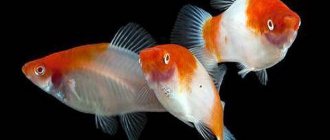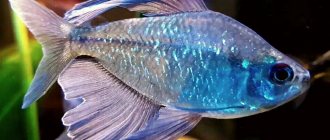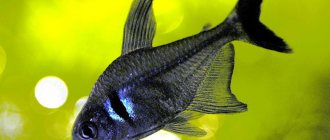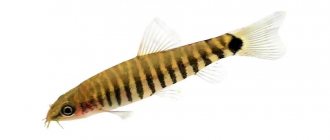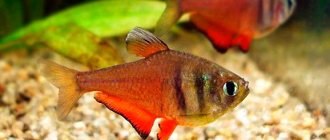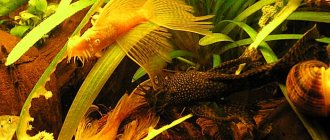These fish come from Brazil, in particular, their habitat is the Aritsuanan River. I would like to immediately note that Kerry Inpaichts are very unpretentious, and therefore are an ideal option for beginner aquarists and other lovers of home aquariums.
Slender light bluish males are amazingly beautiful; as a rule, they are slimmer than females and shimmer with bluish shades when reflected light hits them. Their terminal anal fin is presented in the form of a rounded shape.
Female Kerry Inpaichts have a more rounded abdomen and are colored yellow-brown. The anal fin of females appears pointed at the end.
Also, one of the differences between males and females of Kerry inpaichts can be confidently attributed to their adipose fin. Males have a bluish fin, while in females it is mixed with reddish colors.
In aquarium conditions, these fish reach a length of up to five centimeters and live for approximately four years.
Peace-loving Kerry Inpaichts keep in packs, and therefore it is better to keep them in numbers of at least six to eight pieces. In schools, fish feel much more comfortable, look great and become less timid.
Food and proximity to other species
Cannibalism is not typical for Kerry. They do not eat other fish. Although, as
insurance, experts recommend placing a net at the bottom of the aquarium so that the eggs
was out of reach of adults. You never know.
Other non-predatory fish of the same size can be kept together with kerri. There are no wars
will.
For feeding you need to buy both animal and plant food. Need to treat more often
fish food of animal origin.
It is recommended to feed your decorative pets once a day strictly
dosed amount. Kerry is also a glutton and can get fat.
Aquarium
The Kerry fish does not like living alone. It belongs to the schooling species of fish, so the Kerry will feel more comfortable surrounded by 8-10 neighbors. The optimal volume of an aquarium for 15 individuals should be at least 60 liters. If you plan to keep more fish, then you need to take care of purchasing an aquarium with a larger capacity. The fish are quite unpretentious, so the aquarium is equipped with minimal equipment: lighting, thermostat, filter and compressor. Carries will enjoy having plants in the tank, but they also like movement, so you will need to leave more free space for swimming. It is better to cover the aquarium with fish with a lid so that the fish do not jump out. To fully enjoy the beauty of Kerry fish, you can install side lighting in the aquarium.
Content
It is very important to choose the right lighting angle, because sometimes, in the rays of light reflection, fish can shimmer with beautiful lilac shades. Particular emphasis should be placed on side lighting, then the fish will begin to stand out due to the increasing contrast.
The character of males is unchanged. Every now and then, being close to the females, they remain at different angles, clearly demonstrating their beauty to them, which can also please the observer.
Kerry Infant fish can easily be kept both in a separate aquarium and in general, in the vicinity of other peace-loving underwater inhabitants.
It is very good if the fish adjacent to them are comparable in size to the Kerry Inpaicht. The volume of the aquarium tank should be fifty or more liters, and have a length of fifty or more centimeters. A flock of six Kerry Inpaichts will feel comfortable in such a space.
In addition to its size, the aquarium should be fairly densely planted with vegetation, including floating plants, as well as providing free space for the school to swim. Mostly fish choose the middle and upper layers of the water space of the aquarium, where they spend most of their time.
For proper maintenance of Kerry Inpaicht, pay attention to the water parameters, they should be as follows:
— temperature 23-25°C;
— hardness dH from 4 to 18° degrees;
— pH acidity balance should correspond to the reading of 6.5-7.5;
— filtering is required;
- aeration;
- daily change of clean water approximately 1/5 of the total volume of the aquarium.
Strictly follow the feeding dosage, since Kerry Inpaichts are very prone to overeating. The diet may include various foods: dry, live, frozen. In general, food of animal origin should predominate in proper fish nutrition.
From time to time, it is necessary to feed them with plant foods, in the form of flakes. Kerry Infants love to feast on various small insects, and when hunting for them, they can jump out of the water quite quickly. Take this feature of your pets into account and cover the aquarium with a lid.
The Kerry tetra (Inpaichthys kerri), which is also called the Purple Emperor Tetra, the Royal False Tetra, according to many interested in aquarium hobby, is one of the most beautiful representatives of Characidae, such as tetras.
The habitat of this fish, growing up to 3.5 cm, is reservoirs with smoothly flowing water in the tropical forests of the Amazon tributary basin - the Madeira River.
The bottom of such reservoirs is littered with fallen leaves and branches. Therefore, the ideal keeping conditions for the Kerry tetra would be an aquarium with sandy soil, on the bottom of which dry leaves or alder catkins are placed. Such a substrate will not only acidify the water (tetra kerry needs water with a pH of 5.5-7.0, dGH 1-12), but also enrich it with tannins and other tannins, but also give it a brown tint.
Also in the aquarium you will need driftwood to create shelters, dense thickets of plants that can grow in dim lighting.
Over the years of being kept in aquariums, tetras have acclimatized perfectly. They are unpretentious and non-aggressive enough to recommend them to beginning aquarists.
They are kept in schools of 8 fish or more, which requires an aquarium with a volume of 70 liters. The temperature range is 24–27°C.
Queen tetras accept all types of frozen and dry food. But the full beauty of the unique coloring will appear only if the basis of the diet is made up of live food - small crustaceans, bloodworms, correts.
A flock of 8–10 fish will require a tank with a volume of at least 70 liters. In the design I use a sandy substrate with numerous shelters in the form of driftwood or other decorative elements, dense thickets of plants that can grow in dim lighting. To simulate natural water conditions, dried fallen leaves, oak bark or cones of deciduous trees are immersed in the bottom. Over time, the water will turn a characteristic light brown color.
These leaves can be purchased at aquaMegaMall.ru. Before being placed in the aquarium, the pours are washed under running water and soaked until they begin to sink, and then placed on the bottom of the aquarium.
It would be a good idea to acidify the water by using peat-based filter materials to purify the aquarium water. Such materials and filters are also available at aquaMegaMall.ru.
Also, to create optimal living conditions, you need to change 15%-20% of the water weekly, regularly clean the soil from food debris, excrement, and change rotting leaves and alder cones.
A peculiarity of the behavior of Kerry tetras is an increase in aggressiveness when kept alone or in a school of less than five individuals. Tetras begin to try to bite the fins of their neighbors and oppress smaller fish. If the school is increased to at least the minimum, suitable number of fish (8-10 pieces), the behavior changes and the fish interact only with members of the school.
Under optimal conditions, Kerry tetras spawn in a community aquarium.
If the goal is to obtain a large percentage of offspring, you should set up a spawning aquarium (about 20 liters) and put the fish there. But they are covered with a fine mesh net to protect the eggs, or with mosses or small-leaved plants. The stimulus for spawning is a smooth change in pH to 5.5-6.5, a decrease in dH to 1–5 and an increase in temperature to 27°C. Diet: live nutritious food. First, females with bellies rounded from eggs are placed in the spawning tank; the next day, males, who are most brightly colored, are placed. After the eggs are laid, the parents are removed.
The larvae appear within a day or two, and on the third or fourth day they actively swim and feed. They are fed with live microfeeds.
Video: Kerry Tetra (Inpaichthys kerri, Purple Imperial, False Royal)
Reproduction
For spawning it is necessary to raise the temperature to 24-26 degrees. Other indicators
remain the same as in normal times.
To do this, use a separate container with a water level of 12-15 cm - a spawning tank. There
a mature pair is planted. The spawning tank can be located either in the main aquarium or
and separately from it. Consult with our specialists which option
best suited for you!
The female, ready to breed, begins to fussily circle around the aquarium - it’s her time
sit down.
Each female leaves about 300 small eggs. They are unable to attach to
something and fall to the bottom. It is best to plant a small plant with leaves there,
eggs will fall on it.
After the eggs are laid, adult fish are placed back in the main aquarium, and
The spawning tank is darkened until the fry appear.
Experts suggest using melted or rain H2O that has undergone purification
through a carbon filter to create the necessary conditions for spawning (if you
If you use the services of professionals, you won’t have to do anything yourself).
Aquarium Kerry fish are ready to breed at the age of 4-6 months. Recommended
Start this procedure at 6 months of age.
The eggs ripen within half a day, and on the fifth day the fry appear, emerging
to the surface for feeding. Feed them protozoa (rotifers, daphnia,
ciliates-slippers). They grow quickly.
Breeding
Kerry tetras are often bred, so this activity cannot be called difficult. In order to grow a large number of fry, you will need a separate container with a volume of about 20-30 liters.
The spawning tank should be very dimly lit, and its bottom should be lined with a spawning substrate, which is small-leaved plants or their various analogues, for example, green nylon washcloth. To prevent producers from feasting on their own offspring, the substrate can be covered with a separator net, the mesh of which should be larger than the eggs, but at the same time preventing the fish from reaching the clutches.
Water for spawning should be soft and acidic:
- acidity: 5.5-6.5 pH;
- hardness: 1-5 °gH;
- temperature: 24-27 °C.
Water that has undergone peat filtration is very suitable for spawning. To soften the medium, you can dilute distilled water. It is advisable to install an airlift filter in the aquarium, which provides a weak current and does not suck in the fry.
The fish selected for spawning are separated by sex and fed generously with high-protein feed for a couple of weeks. As soon as the males acquire a brighter outfit, and the females fatten up their noticeably rounded abdomens, the fish are released for spawning. Tetras can be propagated either in pairs or in groups, where there are 2 males per female.
The spawners are moved into the spawning area in the evening, and they begin breeding at the first rays of the sun. Tetras are not averse to eating eggs at the first opportunity, so after spawning, the spawners are immediately removed from the spawning area.
Incubation of eggs lasts from 24 to 48 hours, depending on the temperature. For the first 3-4 days after hatching, the larvae lie motionless on the bottom and feed from the contents of their yolk sac. As soon as the babies begin to swim in search of food, you can give them “live dust”.
As the fry grow older, the feed fraction is increased, first gradually introducing egg yolk into their diet, and then artemia nauplii and microworms.
In the first months, it is important to organize frequent and regular feeding in small portions - 6-8 times a day, as well as daily small water changes - about 10% per day. In such conditions, the juveniles will grow faster and with the least waste.
Behavior and Compatibility
Peaceful schooling calm fish. They react poorly to noisy, overly active neighbors, such as Barbs or African red-eyed Tetras. Kerry is perfectly compatible with other South American species, such as small Tetras and catfish, Pecilobricon, Hatchetfish, and rasboras. This species has an undeserved reputation as a fin nipper. The Purple Tetra does have a tendency to damage the fins of its tankmates, but this only happens when it is kept in a small group of up to 5-6 individuals. If you maintain a large school, the behavior changes, the fish begin to interact exclusively with each other.
Let's meet: Kerry Inpaicht
The ornamental Inpaichthys kerri belongs to the Characidae family.
Its natural habitat is the Brazilian Aritsuanan River. It is often said that the kerry is a fish similar to the king tetra, and this is a fair comment. It is characterized by sexual dimorphism (representatives of different sexes differ from each other)
appearance): males are silver-blue, and females are yellow-brown.
Males shimmer very beautifully due to the reflective features of their scales
from light blue to pink flowers. A light blue line stretches along the entire length of their body.
strip.
These are miniature fish no more than 5 cm long. Thanks to this, they are convenient to keep in
small aquariums.
Males are slimmer than females, whose abdomen is more rounded. In addition, females are smaller
in size than males.
Let's pay attention to the features of the fins:
- In males, the rear fin is rounded and has no sharp corners; in females it is pointed.
- The adipose fin of females is colored red, while that of males is blue.
- It is very convenient to distinguish males from females by size, body slenderness and coloring
body and fins.
Habitat
Comes from the upper basin of the Madeira River, the largest tributary of the Amazon.
It lives in numerous river canals and streams flowing through the tropical forest. The water is opaque, very acidic (pH below 6.0), colored light brown due to the high concentration of tannins and other tannins released during the decomposition of organic matter (leaves, branches, tree fragments, etc.). Brief information:
- Aquarium volume - from 70 liters.
- Temperature - 24–27°C
- pH value – 5.5–7.0
- Water hardness - soft (1–12 dGH)
- Substrate type - sand
- Lighting - dim
- Brackish water - no
- Water movement - weak/moderate
- The size of the fish is up to 3.5 cm.
- Food - any food
- Temperament - peaceful, calm
- Maintain a flock of at least 8–10 individuals
